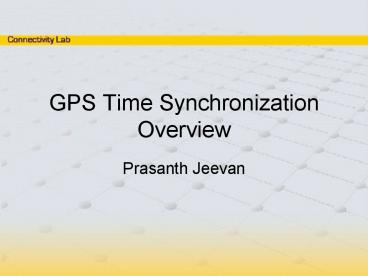GPS Time Synchronization Overview - PowerPoint PPT Presentation
1 / 15
Title:
GPS Time Synchronization Overview
Description:
24 active satellites, 2 rotations per day. At least 4 visible ... http://tf.nist.gov/time/twoway.htm. Questions? Differential gps and timing. A-gps and timing ... – PowerPoint PPT presentation
Number of Views:138
Avg rating:3.0/5.0
Title: GPS Time Synchronization Overview
1
GPS Time Synchronization Overview
- Prasanth Jeevan
2
GPS Introduction
- 24 active satellites, 2 rotations per day
- At least 4 visible to a terrestrial receiver
- Transmit pseudorandom noise (PRN) codes
- Two that are really accurate for the military
- One for civilians (shorter period, lower chip
rate) - Receiver can get 3D location and GPS time
3
GPS - Trilateration
- 3D works in a similar way with 3 satellites
- Accuracy on the order of tens of meters
- With 4 satellites you get GPS time too
- If you just want GPS time
http//Illumin.usc.edu
4
GPS for Time Sync
- you can do it with one satellite!
- Why do you want the time from GPS?
- Each satellite has an atomic clock (1 part in
1012) - Can synchronize multiple clocks via GPS
- Also known as time transfer
- GPS time-transfer unit (TTU), a receiver for this
purpose - Wireless communications would benefit
- GPS timescale is CDMA telecommunications time
scale (accuracy on the order of 10s of
microseconds)
5
Common View (CV) Method
- 2 stations with GPS receivers look at the same
satellite - They simultaneously measure their offset from GPS
time - Repeat many times
- Few parts in 1014 depending on user/site
specifics - A B (A GPS) (B GPS)
- A is Station 1s time
- B is Station 2s time
- GPS is the GPS satellite time
6
CV C/A-code single-channel measurements
- The original way to do CV
- Based on single-channel receivers that could only
look at one satellite at a time - If the two receivers are at the same location you
can ignore coordinate differences, ephemerides,
and ionosphere/troposphere errors
7
All-View method
- Uses new multichannel receivers
- Usually can observe 5 of 12 satellites
simultaneously - International GPS Service (IGS) provides clock
drift and clock offset data - Dont need to just compare common satellites
8
Aside World Time
- Universal Time Coordinated (UTC) is the weighted
mean of 250 atomic clocks throughout the world - CV is used to compare the clocks
9
Limitations
- Hardware temperature sensitivity
- Ionosphere/troposphere delays
- Ephemeris
- Precise antenna coordinates
- Expense
10
Other Enhancements
- GPS carrier phase measurements
- L1 and L2 carriers
- Temperature stabilized hardware
- Standardization of receiver software
- Satellite enhancements
11
Future of GPS
- GPS Modernization Program
- More Satellites
- IIR-M and IIF
- New Bands (with newer generation satellites)
- L2c, L5, more?
- European Galileo, 2010
- Open Service, Commercial Service, Public
Regulated Service and Safety of Life Service - GLONASS, not reliable for now
- Joint development with India started recently
(2005) - Wide Area Augmentation System (WAAS)
- GPS satellite orbit, clock drift, and signal
delays caused by the atmosphere and ionosphere
12
Other GPS Work
- Indoor GPS
- Massively parallel correlators
- Longer duration coherent processing
- Assisted-GPS
- Differential GPS
- A receiver at a known location that tracks the
satellites constantly - similar to/extension of A-GPS concept?
- Centimeter accuracy with WAAS
13
References
- M.A. Weiss et al. A Comparison of GPS
Common-View Time Transfer to All-in-View, IEEE,
2005. - N. Agarwal et. al. Algorithms for GPS operation
indoors and downtown, GPS Solutions, 2002. - W. Lewandowski et al. GPS Primary Tool for Time
Transfer, Proceedings of the IEEE, vol. 8, No. 1,
January 1999. - T. Gotoh. Improvement GPS Time Link in Asia with
All in View, IEEE, 2005. - http//www.wikipedia.com
- http//tf.nist.gov/time/twoway.htm
14
Questions?
15
- Differential gps and timing
- A-gps and timing
- Wide Area Augmentation System (WAAS)
- GPS timing and cellular
- Cellular to relay gps time better?































